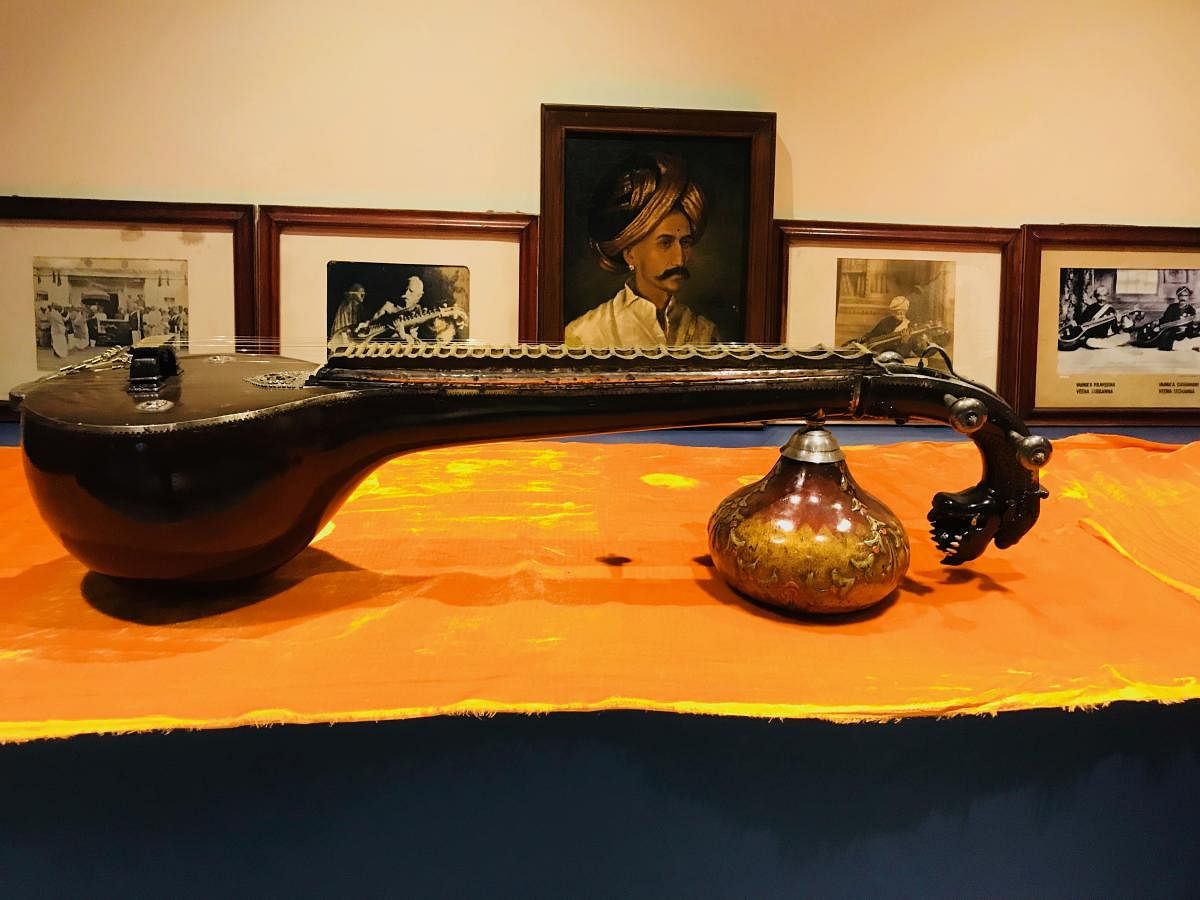
For a country abundant in heritage legacies, India faces the big challenge of conservation. India has had its generous share of people who built stone castles and sold gold on the streets, but such stories are merely fragments of the original saga. Regardless, when we get hold of such fragments, the sense of worth is no short of ecstatic.
The Manjusha Antique Museum in Dharmasthala houses such souvenirs that catch the viewer’s eye and inspire inquisitiveness.
Meet the virtuoso
One such artefact there, placed within an isolated setup, lit by a stealthy shade of red light over orange felt, and radiating an aura of importance, is a musical instrument. Behind it is the picture of the man who laid hands upon it and made it an artefact lucky enough to be a part of the great Carnatic music legacy in Karnataka.
Veene Sheshanna was a legend placed at the zenith of the musical evolution in Karnataka. As the royal musician in the courts of three consecutive Wadiyars of Mysuru, he is known to have elevated the standards of Carnatic music to levels unseen before, and heralded a beginning of innovation and higher standards in the area.
Veene Sheshanna, as the prefix of his name suggests, was a master vainika, or a player of the veene.
He lived from 1852 to 1926, during which he grew to be one of the most skilled musicians in history.
The veene that he used was a standard one, which was preserved for more than a century, before it was handed over to the antique collection of Dharmasthala by Sheshanna’s great-grandson, the famed music analyst
V Subramanya.
The instrument was created out of a single tree and has silver icons fused into the body. The instrument is still under working condition. It is distinguished by the icons of Garuda — or the Gandaberunda — which was the sigil of the Mysore dynasty. And there is a Saraswathi on top of the reverberating surface, which is said to have been gifted to Sheshanna by Nalvadi Krishnaraja Wadiyar for his enchanting performance at the king’s durbar.
However, what clearly marks it is the silver serpent delegated atop the other end of the reverberating surface, just above the string keys. An interesting story backs this feature. It is said that a serpent made its appearance at a musical concert at Parthasarathy Sangeetha Sabha Bhavana in Madras as Veene Sheshanna was delivering a performance on his instrument.
To the shock of everyone present, it seemed to heed his music before sliding away a while later, causing no harm or unrest to Sheshanna, who was occupied in the process of playing, with his eyes closed. Recognising this incident as a testimony to his musical skills, a popular musician and vainika himself, Shaila Srinivas Iyengar, gifted to him the silver serpent, which was later incorporated into it.
It’s a Saraswathi veene, which is native to Carnatic music, as opposed to the Rudra veene, which is recognised with Hindustani music.
Mysore V Subrahmanya, the great-grandson of Veene Sheshanna, says that Sheshanna was the first musician to bring music from within palaces to the common people.
Even without amplifiers, Sheshanna would hold concerts and play for an audience over 100. As the only musician who dared to break the convention, he earned over 30 titles of reverence and a vast admirer base even at international levels. The display at Manjusha also houses a couple of photos of him playing the instrument.
The masterpiece is the life-like painting of Sheshanna in his youth painted by Raja Ravi Varma. It is said that the painter, also a music lover, loved Sheshanna’s devotion to the art.
Veene Sheshanna’s musical bequest was as far stretched as the British empire back then, validated by the fact that there was a portrait of him at the art gallery of Buckingham Palace, incorporated there by George the Fourth, who happened to admire Sheshanna at the Delhi durbar multiple times.
And then...
Other than the veene, Sheshanna was a master of many other instruments including the violin and piano, and was a vocal artiste. His expertise with the veene was such that he changed the very style of playing it — Sheshanna began playing it in a horizontal manner, which then became the mandate for all vainikas. Before this, musicians held it vertically.
Quoting his words, “I can give my best; who can give the best that the veene is capable of?”
He has 53 compositions to his credit. Most of them are in Telugu and five are in Kannada. His compositions include swarajatis, padas, javalis and many thillanas.
His understanding of Hindstani music was commendable.
References of his works can be found in the books Music of Hindustan by Fox Strangways and The Music of the Orient And The Occident by Margaret E Cousins. Also, Sangeeta Kalabhivruddhi Sabha of Mysuru has published his compositions, making it accessible to the public. Titled ‘Vainika Shikhamani’ for his unparalleled endowment in veene, Sheshanna was by all means an asset that the music world documents in golden letters. His instrument, proudly displayed at Manjusha, is a souvenir of his lifelong successful association with music.
Ritesh Sharma, the deputy director of the museum, states that the instrument is amongst the most precious artefacts they have, and combined with Raja Ravi Varma’s depiction, it makes for a highly valuable entourage, which has earned it a specialised display setup.
More so, it is an artefact that came looking for Manjusha through the events of history.